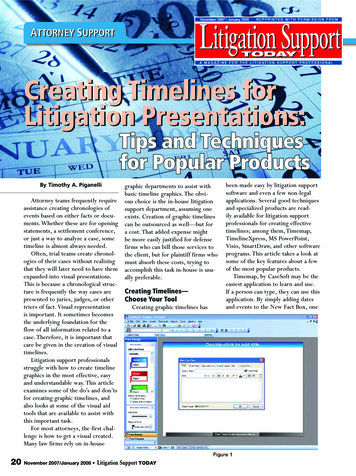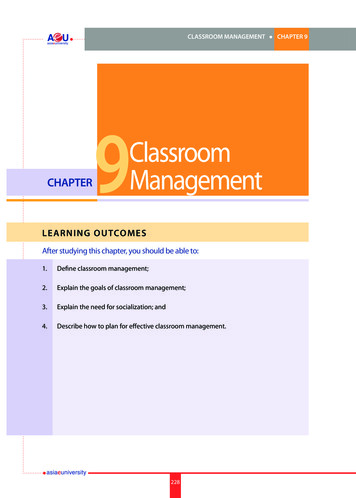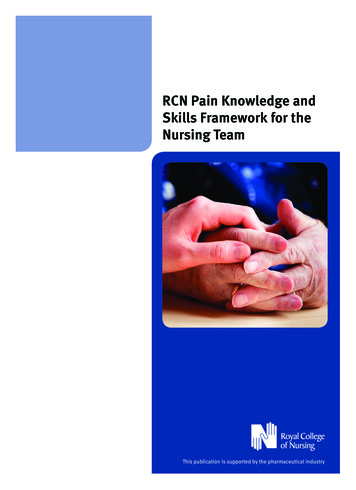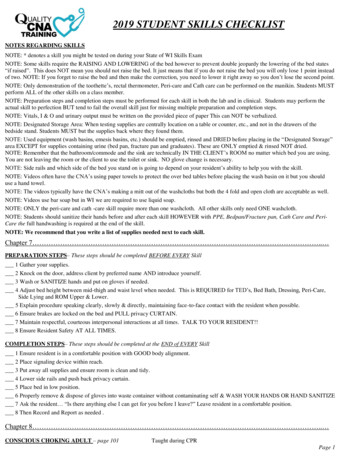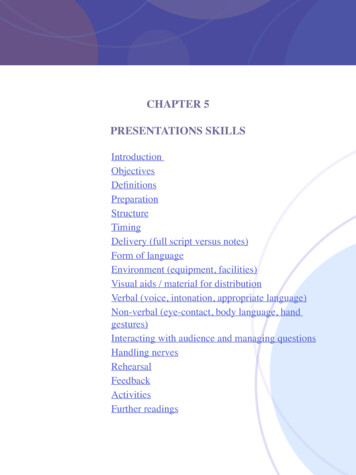
Transcription
CHAPTER 5PRESENTATIONS StructureTimingDelivery (full script versus notes)Form of languageEnvironment (equipment, facilities)Visual aids / material for distributionVerbal (voice, intonation, appropriate language)Non-verbal (eye-contact, body language, handgestures)Interacting with audience and managing questionsHandling nervesRehearsalFeedbackActivitiesFurther readings
SOFT SKILLSPRESENTATIONS SKILLSPRESENTATIONS SKILLSINTRODUCTIONWell-developed presentation skills enable you to communicate clearly, precisely and effectively in a variety ofmodes or registers and settings. It should be pointed out that they are rated as one of the most important softskills. The ability of communicating with the audience and giving presentations should be seen as a mandatoryprerequisite for both the effective learning process and the successful working life.Thus, it is imperative to gradually increase and enhance your presentation skills through a continuous trainingthat will help you to become more competent, confident and competitive.The purpose of this chapter which is based on the best Western practices is to help to develop your presentationskills. It first introduces the basic premises of giving a presentation by examining in details its preparation,structure, timing, form of delivery and language, equipment and facilities, visual aids and material for distribution.The subsequent sections cover more specific topics including verbal (voice, intonation, appropriate language)and non-verbal communication (eye-contact, body language, hand gestures) communication, interacting withaudience and answering questions, handling your nerves during the presentation. The chapter concludes byfocusing on rehearsal activities and different forms of feedback which will enhance your presentation skills.OBJECTIVES: to develop your skills to communicate clearly, effectively and confidently with a range of audiences in arange of different contexts; to improve your research and design skills, and strengthen your delivery techniques; to enhance your use of different support electronic and other visual tools; to reinforce your performance skills (verbal and non-verbal); to increase your confidence level in interacting with audience and control your nervousness; to promote critical and reflective thinking by dealing with feedback on your presentation skills.-142-
SOFT SKILLSPRESENTATIONS SKILLSDEFINITIONSThree types of presentation might be identified:1. Information-giving. This is predominantly descriptive, giving or summarising information. You may beasked to do this as part of a mini-teaching session, sharing theoretical or factual information. Here the pointis to see what you have understood and how you have extracted the main facts from your reading and to relaythese to the group. You will need to make decisions about what information to include.2. Discursive. Here you will need to debate the strengths and limitations of an approach or develop an argument,exploring and weighing up different perspectives, challenging your audience to accept a different viewpoint.For this, you will need to decide your ‘angle’ – are you for or against it, weight pro and cons? Pull youraudience in, challenge and confidently debate.3. Demonstrative. This type of presentation tends to be used in the context of training: for example, whendemonstrating your ability to illustrate your understanding of a technique or teaching a practical skill toothers. (Craig, C., 2009)Presentations are key activities and might include: Group and individual presentations for a given topic as part of a module assessment. Seminar presentations giving a paper to an academic or your peers for the purpose of teaching or showingevidence of your understanding of the topic. Providing an overview of some research carried out by you or your group. Demonstrating the use of a piece of equipment or software such as PowerPoint to show that you havedeveloped the essential skills to use it appropriately. Dissertation-related presentations and Vivas to demonstrate your ability to manage a research project. A job interview where you have been asked to present for several minutes on a given topic. (Chivers B.,Shoolbred M., 2007)PREPARATIONUsually, the majority feel nervous when presenting something. It is mainly due to the fact that in a livepresentation there is no second chance. Plus, you should be aware that the way in which information or ideasare delivered strongly affects how they are understood by the audience. Even tiny inaccuracies in presentationcan make it hard to follow. Thus, for communication to take place effectively presented information has to bereceived as intended by the speaker – and not misinterpreted.-143-
SOFT SKILLSPRESENTATIONS SKILLSThough some of you might be better suited to giving a presentation than your colleagues, actually this is nota skill which you either have or do not have at birth and anyone can be good at presentations. You can masterthese skills like many others, but it requires rigorous preparation, constant rehearsal, deep reflective practiceand constructive feedback.The crucial elements of any presentation are the information that you have to deliver and the audience thathave to receive it. The best presentations are focused with a precise aim and the supplied information isappropriate and addresses the clear-cut, unambiguous question. Poorly prepared presentations are those whichinclude just a bit of everything.Thus, before you start working on the presentation, answer the following questions: What is the main aim of the presentation and what message you want to deliver to the audience in thetime limit set? What is the current knowledge level of the audience and what new knowledge or awareness do you wantthe audience to have gained from your presentation? What is the most effective way to communicate this knowledge?You should remember that planning a presentation can be even more demanding than working on a writtenassignment. The main challenge is to try to fit all gathered information that you usually consider relevant intothe time that is allocated.Some people solve this issue by planning and writing a lengthy piece which can be later reduced to key points.The advantage of this approach is that you will be well prepared with very detailed information which you canfreely use during the presentation particularly if questions are asked. Otherwise, some people compile a set ofheadings, and based on these headings prepare a short paragraph for each point of their presentation.This is your personal decision which approach to use, but it would be more advantageous and safe to preparea detailed paper and then reduce rather than creating a brief set of headings and trying later to add moreinformation. At any rate it would be propitious to have a set of notes to use as a guide during the presentation.It should be pointed out your presentation has to be brief, clear and precise, and provide backup for morecomplex ideas. You should remember that overloading the audience with a very detailed, scrupulous informationwill not automatically make your presentation better. A potentially good presentation might be weakened bypacking it with excessive details and losing a sense of key ideas and conclusions you want to communicate tothe audience.Thus, it would be useful to write down the aims of your presentation. Focus particularly on what new knowledgeor awareness you want the audience to have gained – what will the audience know, understand, or be able todo by the end of the session that they did not know, or understand or were not able to do before?-144-
SOFT SKILLSPRESENTATIONS SKILLSYou might plan the body of the presentation; prepare the first draft of the presentation; prepare the first set of prompts; put the presentation aside for a while review, revise and edit first draft – decide on a ‘good enough’ draft of the presentation; decide on the audio-visual aids that will be useful; prepare the ‘good enough’ set of prompts(Pritchard, A., 2008) (Burns, T., Sinfield, S., 2004) (Barker, A., 2011)STRUCTUREWhether the audience can understand what you are trying to communicate will be determined by how youstructure your presentation. You should focus on the development of a clear structure that will help to map outand guide you in your preparations and in your final delivery.Some authors are quite prescriptive in their approach and suggest that you should: ‘limit your thinking to therule of three: a simple technique where you are never allowed to use more than three main points’ (RichardHall 2007: 320). This can be helpful in focusing your ideas and ensuring that you are clear in what you arearguing. The best approach is to decide your ‘bottom line’ – the key message that you want your audienceto take away – and then work backwards from this so that everything you include leads to this conclusion.(Craig, C., 2009)As a very general principle, the rule of three is offered.1. Tell them what you are going to tell them.2. Tell them.3. Tell them what you have told them.You need to think about how to build your presentation by dividing the material into sections, each one dealingwith one important point. Structure your ideas so that you move seamlessly from one point to another. Thestructure of your presentation will depend on the topic that you are dealing with, but in general there shouldinclude: An introduction, outlining the aim of your presentation and the areas your talk will focus on The main body, containing the substance of your talk and developing the ideas outlined in the introduction A conclusion, drawing together the main points and containing the ‘take home message’ for the audience(Craig, C., 2009)-145-
SOFT SKILLSPRESENTATIONS SKILLSINTRODUCTIONIt is of key importance to get a good beginning. Apart from introducing yourself and subject of your presentation,you should plan carefully about what point of entry will stimulate your audience and at the same time, forma springboard into the main topics of your delivery. When thinking about your openings, keep your audienceand their ‘needs’ very firmly in mind. A good beginning can make the presentation; a poor, inappropriate onecan seriously undermine it. Many people tend to fail to have a proper introduction that contextualises thetopic.Once the ground rules have been established, you then need to outline the main points that you will be coveringduring your presentation. If you can say something that catches your audience’s attention at the beginningand makes them want to hear what follows, then the presentation is likely to go well. You can be creative too.Instead of starting with a series of statements about what is coming next, you could consider stimulating moreinterest by posing a question, presenting a puzzle or a conundrum, showing a picture, or telling a story. Anyof those devices are more likely to capture the imagination of your audience and help you create an engagedand interested atmosphere which can really set the scene for a strong and effective delivery. However, dobe careful of starting with a joke; make sure that it will not cause offence and that it is not too well known.Consider any cultural considerations and sensitivities. (Barker, A., 2011), (Ellis, R., 2010)MAIN PRESENTATIONThis will be influenced by the general context and aim of your presentation and the expected audience. Youmay need to decide between a big picture approach and one that selects a smaller area with more detail. As youdevelop your knowledge of the topic, you will feel more confident about what to include and what to exclude.Identify the key messages. Three or four main points are normally sufficient for a presentation of up to a halfhour. For a longer presentation, do not exceed seven main points in order to avoid overloading your audience.Rember, less is almost always more. You should also decide what is best covered through speech, text, imagesand what could be given in a handout rather than used as presentation content.Support your key ideas by choosing clarifying examples. Because it is usually difficult to follow a spokenargument, you need to make sure that it is relevant, accurate and interesting to the audience, your audiencewill find it easier to maintain concentration and to stay with your argument. You should choose carefullyexamples to provide interest and improve understanding and think where to place them in the structure ofthe content. Use such things as examples, stories, statistics, quotes from expert sources, or research findings.(Cameron S., 2010)-146-
SOFT SKILLSPRESENTATIONS SKILLSCONCLUSIONBecause of the relief of having made it through, otherwise excellent presentations often suffer from anuninspiring, hurried ending. Do not let the pace and energy of your presentation drop at the end. This isthe ‘tell them what you have said’ section. You need to summarise your points, again using visual aids toreinforce them if possible. Always leave your audience with something memorable, say a powerful visual ora convincing conclusion, with a key idea, a central theme to take away and want to reflect on later. It is alsogood practice to thank the audience for their patience and to invite questions or discussion. (Cameron S.,2010), (Ellis, R., 2010).TIMINGIn most presentations, it is usually better to deliver less content at a reasonable pace, than too much contentat a faster pace that may leave the audience feeling overwhelmed and confused. You should fit the topic intothe allotted time and plan time for breaks, asides, questions. This means you should think clearly about whatto include and exclude from the final version of your presentation.Inexperienced presenters will find difficult to fit into time allocated. On the one hand they have prepared toomuch material and then have to jump to their conclusion, rushing over key points and running the risk ofleaving their audience confused. On the other hand they have under-prepared and have to face one of the mostembarrassing of all public speaking experiences – running out after ten minutes with your audience expectingthe full half hour.Where the presentation timing is preset, it is important that the pace of the verbal and image presentation arein a correct sequence. In five minutes your message must be to the point with little by way of illustration.Twenty minutes, on the other hand, will enable you to make an impact both verbally and visually. Ensure thatyou are not trying to squeeze too much information into the allocated time. Enough is enough; no one wants tohear you rushing through the material in the hope of getting to the end. Rehearsal will help you to set realistictiming and adjust your pace of delivery to accommodate pauses and changes of voice tone for emphasis. Youwill then be able to edit the content, perhaps deciding what facts you need to discuss and what can be coveredin the handouts or visual aids. (Malthouse, R., Roffey-Barentsen, J., 2010), (Ellis, R., 2010). (Craig, C.,2009), (Van Emden J., Becker L., 2004)-147-
SOFT SKILLSPRESENTATIONS SKILLSDELIVERY (FULL SCRIPT VERSUS NOTES)Inexperienced presenters attempt to write down the whole speech, even including ‘Good morning ladiesand gentlemen’. They prepare a closely drafted text, each line filled, with very little space left. Experiencedpresenters have their own style of notes, but never fill the page with text. You can organize your speech notesin many ways and it is very much a personal preference. When it comes to the actual presentation you needto decide whether you will read from what amounts to a script, or whether, based on your notes, you willspeak without reading directly. Certainly when a presentation is delivered in one of these two ways there is anoticeable difference, and in most cases the reading of a script comes across definitely less well. It dependsto a certain extent on the way that you have written the script. If it is written in a formal academic tone thenit will sound overformal. If you are able to write it in a more conversational style, then you will have a betterchance of making it sound natural.Apart from very brief, well-chosen text, it is better not to read from a prepared text. A written text from whichyou need to read can stand like a literal barrier between you and your audience, but also typically when peopleread their voices go dead and they deliver the topic in an ill-paced monotone that has the average audiencelosing interest after about the second sentence. If you are marking for successful communication, then anaudience must be listening to and following your presentation. You should work to become as comfortableas possible with your material in advance, so that you do not need to rely on a prepared text. Delivering yourpresentation using a natural conversational style is the best way to make the most of face-to-face presentations,and is much more likely to result in a performance that everyone will evaluate positively. Try do not pack toomuch into your notes – they are, and must always be, a distillation of your preparation, not a script of all thatyou have prepared. Your notes must support, not distract you.There will be times when you may need a fuller script and these short notes will not be enough, especialialyyif you have to give a paper. Again, do not clutter up your page. Remember to put in some markers when youcan pause and paragraph breaks. Many presenters use a cue card system. For each point they are to make,they write a heading, a short phrase or two, or a set of key words, on a post card, or similar, and arrange thenumbered cards in the correct order to follow through the presentation. These cards might also have otherreminders: ‘Refer to diagram’; Write in bold and in the centre of the card so that you do not have to peer. Theseare particularly useful when you have to walk about while you are presenting. (Barker, A., 2011), (Moore S.,Neville C., Murphy M., Connolly C, 2010), (Pritchard, A., 2008)FORM OF LANGUAGEIt is important to recognise and respond to the difference between formal written language and spoken language.When giving a presentation it is not obligatory to use complicated language constructions, to use long words,or to speak in nested and convoluted sentences. If you choose to speak in a way that does not necessarily comenaturally to you, or is in some way made more complicated than it needs to be, you will in all probability not-148-
SOFT SKILLSPRESENTATIONS SKILLScommunicate effectively. This does not mean that you should not use correct vocabulary, especially whendealing with technical terms, which clearly form an important element of the content. There is a case forgiving an explanation, or simple definition, of technical terms as they arise for the first time, particularly ifyou are dealing with an area of your subject which is new to the audience. Use correct language and proofread(words used appropriately; correct spelling and punctuation). It is essential to check your work for errors.Also follow general principles: avoid gender stereotyping; avoid racist and racism stereotyping; avoid beingaggressive, swearing or obscenities; use the language that can include everybody (Pritchard, A., 2008), (Drew,S., Bingham, R., (2010)ENVIRONMENT (EQUIPMENT, FACILITIES)You should find out when your presentation will take place. The danger spots are immediately before orafter lunch and last thing in the afternoon when your audience may be distracted by thoughts of dinner or thejourney home. During these times, the more interactive your presentation can be, the greater the chance youraudience will be attentive and engaged.Another important aspect of planning concerns the location of your presentation. This can have significantimplications for how you plan your content and organise yourself. Go to see the room in which you will bepresenting in advance of arriving for the actual presentation.If you have access to the venue, it might help to pay an early visit. If this is possible, listen to other presenters inthe same room. The aspects you might want to check include: type and size of room seating arrangements –fixed or movable lighting – artificial or natural? acoustics equipment available, e.g. whiteboard, projector,OHP, flip chart, tape recorder location of power points position of speaker (you) facilities for specialneeds (The-learning-guide) (Craig, C., 2009) (Drew, S., Bingham, R., 2010)VISUAL AIDS / MATERIAL FOR DISTRIBUTIONIf you use more pictures and diagrams than text, you will possibly help the audience to understand better whatyou are saying. This is because after three days an audience will have retained 7% of what they read (bulletpoints, or other notes on the screen), but 55% of what they saw pictorially (charts, pictures, diagrams).You should be aware that visual aids are complementary to the presentation and you should not focus toonarrowly on visual aids because you will lose the key point of presentation.-149-
SOFT SKILLSPRESENTATIONS SKILLSVisual aids can: Help audiences understand the presentation itself. For example, writing up the agenda of the talk on theboard or as a handout will help an audience follow the structure of the presentation itself. (clarify themeaning) Emphasise different parts of the presentation. Here you might underscore a key word or point by capturingit on a PowerPoint slide, by giving a supporting quote or reference or by producing a illustrative imageor object. (visual aids reinforce what you say) Take the pressure off the speaker. For a brief while all eyes are on something else for a moment. This isa good thing. (people tend to look at the visual aid rather at you, it helps when you are nervous)(Burns, T., Sinfield, S., 2004) (Ellis, R., 2010)When you think about what makes presentations effective, it will be convenient to consider how you can useimages to communicate more effectively. It will be useful to remember these general principles: Use images to improve understanding. Sometimes, it is easier to use a picture instead of words to improveaudience understanding. When you show a picture, you can ask them a question or suggest they thinkabout the image in a certain way. You can then remain silent while they think about the image or the taskyou have set them. Images can also be used to direct audience attention away from you and onto theimage on the screen. This may help to steady your nerves as it gives you a few seconds to perhaps takesome deep breaths or check your notes. Use images to save time. If there is only a short amount of time you could include images as a quick wayto cover some of the content. You have probably heard of the phrase, ‘a picture paints a thousand words’and this is very relevant to a student presentation. Use images for interest. Images use the visual sense whereas sound and speech use the auditory sense.Providing content in a variety of formats means that the audience has to use of a range of senses. Thiskeeps them active in the process of receiving the presentation. We all have preferences and using avariety of communication approaches ensures a wider appeal to different members of the audience. Use images for impact. Images are more relevant for some topics than others but even if only a few canbe included, they can be useful to create pauses and breaks in the delivery, generate discussion themesor make a lasting impression. (Chivers B., Shoolbred M., 2007)-150-
SOFT SKILLSPRESENTATIONS SKILLSTips for PowerPoint presentations:1.Avoid clutter slides at all costs2.Select a clear font such as Arial or Helvetica.3.Use bold rather than underline and avoid italics;4.A dark background (deep blue or black) and light coloured text (white or yellow) for contrast willmake your words stand out (Use of colour that detracts from the main content of the slide, or thatmakes reading the text difficult.)5.Use a font size of 20 or over: use a 36 point for titles and a 28 point for body text6.Spelling and /or grammar mistakes7.Use pictures and icons and beware of the special effects, e.g. spinning words or sound effects8.Keep the presentation consistent, e.g. background and style. Do not suddenly switch fonts half waythrough. You may not notice but your audience will9.Less than 30 words per slide, 5–6 words for headings a maximum of five bullet points per slide10. Keep the number of slides down to one per minute or even one per 40 seconds(Malthouse, R., Roffey-Barentsen, J., 2010), (Craig, C., 2009)Handout materialSometimes you will be expected to produce a handout of some kind. Handouts can be taken away as a reminderof what you said. Handouts can have details that might clutter up your presentations. Handouts distributed atthe end can be a good way of concluding, but you need to tell people at the beginning that you are going to dothis, otherwise they can feel annoyed if they have taken careful notes which the handout makes superfluous.You need to consider the style and content of handout material, as well as the purpose. Some options are: Main points/headings. Notes generated by the presentation software that you have used. Possibly an edited version of a longpresentation would be a good idea. Headings/main points, with space to write notes. Diagrams. Charts. Statistics. References.Avoid giving handouts while you speak. The distribution of handouts while you are talking distracts people,and you will lose your audience. It does not matter how often you say of a handout ‘don’t read this now’ – thetemptation to look at it immediately seems universally irresistible. (Cameron S., 2010) (Pritchard, A., 2008)-151-
SOFT SKILLSPRESENTATIONS SKILLSVERBAL (VOICE, INTONATION, APPROPRIATE LANGUAGE)However, it is not possible to use images for everything in your presentation. But be aware that up to 38% ofwhat is taken in by those present is through the spoken word, which highlights the clear need for what you sayto be audible and very much to the point.You should remember that your voice is an incredible tool. On average 7% of what the audience understandcomes from the words that are used within the verbal interactions, compared with 38% of information resultingin tone of voice and 55% being dependent on non-verbal cues. Use this to your advantage. Presentations aregreatly enhanced by varying the tone of voice to emphasize aspects of the content. Make sure you projectyour voice to the back of the room. Try to vary the tone of your voice and the speed or pace of delivery to giveemphasis to different parts of what you say. Use silence to your advantage. A short pause can give emphasisto a point you are making.One of the ways in which inexperienced presenters betray their lack of skill is that they fade in volume. Theymay begin their talk with reasonable audibility but this decreases as they forget to project their voices inaccordance with the size of the audience (the more bodies, the more the sound is absorbed) and the acousticsof the room. Good projection should not be a matter of straining but of being aware of where the voice isgoing, and making effective use of breathing to support the voice. Presenters who fail to project are usuallytoo busy peering at their notes and being worried by what is coming next.Another concern for those giving presentations is that of speaking too quickly. When speaking to an audienceof any size it is advisable to speak more slowly than your normal speed, and to leave pauses occasionally.Speaking more slowly and pausing is even more important if you want the audience to pay attention to words,diagrams or pictures on a screen at the same time. Speaking slowly is not the same as speaking hesitantly, andalthough being nervous might lead to hesitance, it is a good idea to work towards eliminating this.Be enthusiastic about what you have to say. If you fail to show any interest, there is little chance that youraudience will be attentive and engaged. Nothing is as boring as a monotonous voice reciting a presentationthat has obviously been memorised and delivered on many occasions or, even worse, reading from notes. Tokeep your presentation alive there needs to be an element of spontaneity. This can be achieved by varying thepitch and tone of your voice in relation to the subject matter. Speeding up your delivery is another techniquethat will keep the audience’s attention. Sometimes this is followed by a moment of silence (just for effect) andthen a calmer, more measured approach follows. Experiment with this during your rehearsal to ensure that youdo not come over as being a little manic.(Craig,C.,2009), (Malthouse, R., Roffey-Barentsen, J.,2010), (Pritchard,A.,2008) (Ellis, R., 2010) (Mehrabian,1981).-152-
SOFT SKILLSPRESENTATIONS SKILLSNON-VERBAL (EYE-CONTACT, BODY LANGUAGE, HANDGESTURES)Eye contact. Eyes are one of your best tools for involving the audience in what you are saying. Good posture,movement and gestures will be of little use if you fail to support them with appropriate eye contact. Greatpresenters understand that eye contact is critical to building trust, credibility, and rapport. Far too many havea habit of looking at everything but the audience. One way of spotting inexperienced presenters is to seehow they focus on a small group, usually in front of them and usually those giving off positive expressionsof interest or encouragement. This focusing has the effect of rather embarrassing those people while, at thesame time, losing contact with others in the audience. Those who started with rather negative feelings towardsthe speaker will be unlikely to have such feelings ameliorated if they are never looked at, seemingly neverincluded in the occasion.It is advisable to maintain eye contact with your audience at least 90% of the time. It is appropriate to glanceat your notes or slides from time to time, but only as a remin
SOFT SKILLS-142-PRESENTATIONS SKILLS PRESENTATIONS SKILLS INTRODUCTION Well-developed presentation skills enable you to communicate clearly, precisely and effectively in a variety of modes or registers and settings. It should be pointed out that they are rated a
